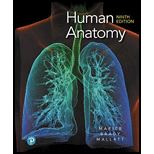
What structural features of capillaries make them well suited for their function of nourishing body tissues and removing waste products?
To review:
The characteristics of capillaries that enable them to nourish corresponding body tissues and to remove waste from them.
Introduction:
The human circulatory system is associated with the transportation of nutrients and gases throughout the body and it has a proper channel to perform this function. There are various structures associated with this channel and the smallest structures are known as the capillaries.
Explanation of Solution
The smallest blood vessels in the human body are capillaries with a diameter of 8 – 10 micrometers. The capillaries possess gaps of unjointed endothelial cells along with tight junctions. These gaps enable gaseous exchange and transportation across the capillaries. The gap junctions are of variable size and number in various kinds of capillaries enabling their proper functioning at respective locations.
Capillaries provide necessary nutrients and oxygen to the tissues and in turn eliminate carbon dioxide and nitrogenous waste products deposited in them. Some capillaries in the lungs enable oxygen to enter into the blood. Capillaries in small intestine receive the digested food. The capillaries present in the kidneys help to eliminate nitrogenous waste products.
Want to see more full solutions like this?
Chapter 20 Solutions
EBK HUMAN ANATOMY
- What does the heavy dark line along collecting duct tell us about water reabsorption in this individual at this time? What does the heavy dark line along collecting duct tell us about ADH secretion in this individual at this time?arrow_forwardBiology grade 10 study guidearrow_forwardI would like to see a professional answer to this so I can compare it with my own and identify any points I may have missedarrow_forward
- what key characteristics would you look for when identifying microbes?arrow_forwardIf you had an unknown microbe, what steps would you take to determine what type of microbe (e.g., fungi, bacteria, virus) it is? Are there particular characteristics you would search for? Explain.arrow_forwardavorite Contact avorite Contact favorite Contact ୫ Recant Contacts Keypad Messages Pairing ง 107.5 NE Controls Media Apps Radio Nav Phone SCREEN OFF Safari File Edit View History Bookmarks Window Help newconnect.mheducation.com M Sign in... S The Im... QFri May 9 9:23 PM w The Im... My first.... Topic: Mi Kimberl M Yeast F Connection lost! You are not connected to internet Sigh in... Sign in... The Im... S Workin... The Im. INTRODUCTION LABORATORY SIMULATION Tube 1 Fructose) esc - X Tube 2 (Glucose) Tube 3 (Sucrose) Tube 4 (Starch) Tube 5 (Water) CO₂ Bubble Height (mm) How to Measure 92 3 5 6 METHODS RESET #3 W E 80 A S D 9 02 1 2 3 5 2 MY NOTES LAB DATA SHOW LABELS % 5 T M dtv 96 J: ப 27 כ 00 alt A DII FB G H J K PHASE 4: Measure gas bubble Complete the following steps: Select ruler and place next to tube 1. Measure starting height of gas bubble in respirometer 1. Record in Lab Data Repeat measurement for tubes 2-5 by selecting ruler and move next to each tube. Record each in Lab Data…arrow_forward
 Human Physiology: From Cells to Systems (MindTap ...BiologyISBN:9781285866932Author:Lauralee SherwoodPublisher:Cengage Learning
Human Physiology: From Cells to Systems (MindTap ...BiologyISBN:9781285866932Author:Lauralee SherwoodPublisher:Cengage Learning Human Biology (MindTap Course List)BiologyISBN:9781305112100Author:Cecie Starr, Beverly McMillanPublisher:Cengage Learning
Human Biology (MindTap Course List)BiologyISBN:9781305112100Author:Cecie Starr, Beverly McMillanPublisher:Cengage Learning Anatomy & PhysiologyBiologyISBN:9781938168130Author:Kelly A. Young, James A. Wise, Peter DeSaix, Dean H. Kruse, Brandon Poe, Eddie Johnson, Jody E. Johnson, Oksana Korol, J. Gordon Betts, Mark WomblePublisher:OpenStax College
Anatomy & PhysiologyBiologyISBN:9781938168130Author:Kelly A. Young, James A. Wise, Peter DeSaix, Dean H. Kruse, Brandon Poe, Eddie Johnson, Jody E. Johnson, Oksana Korol, J. Gordon Betts, Mark WomblePublisher:OpenStax College





